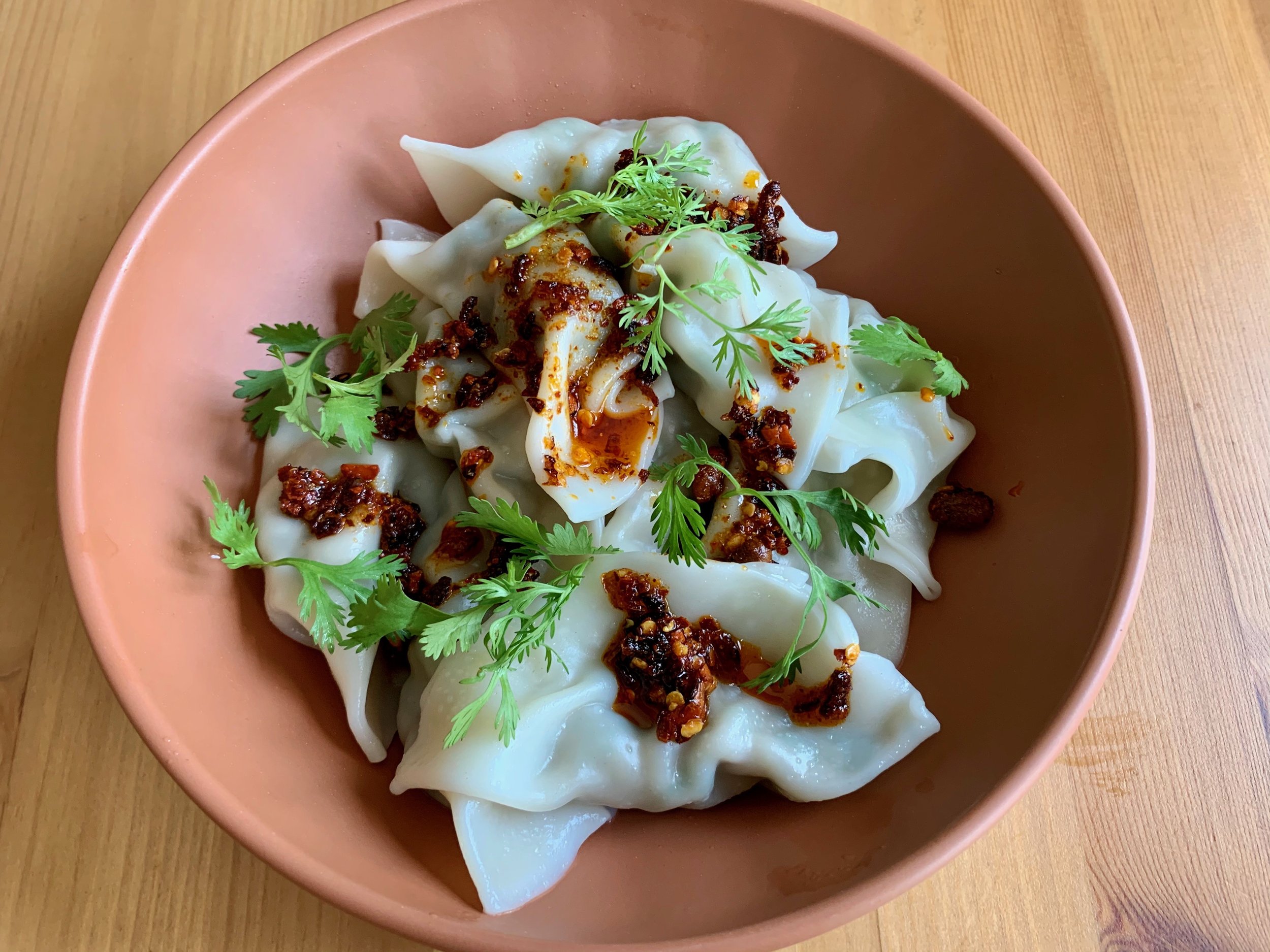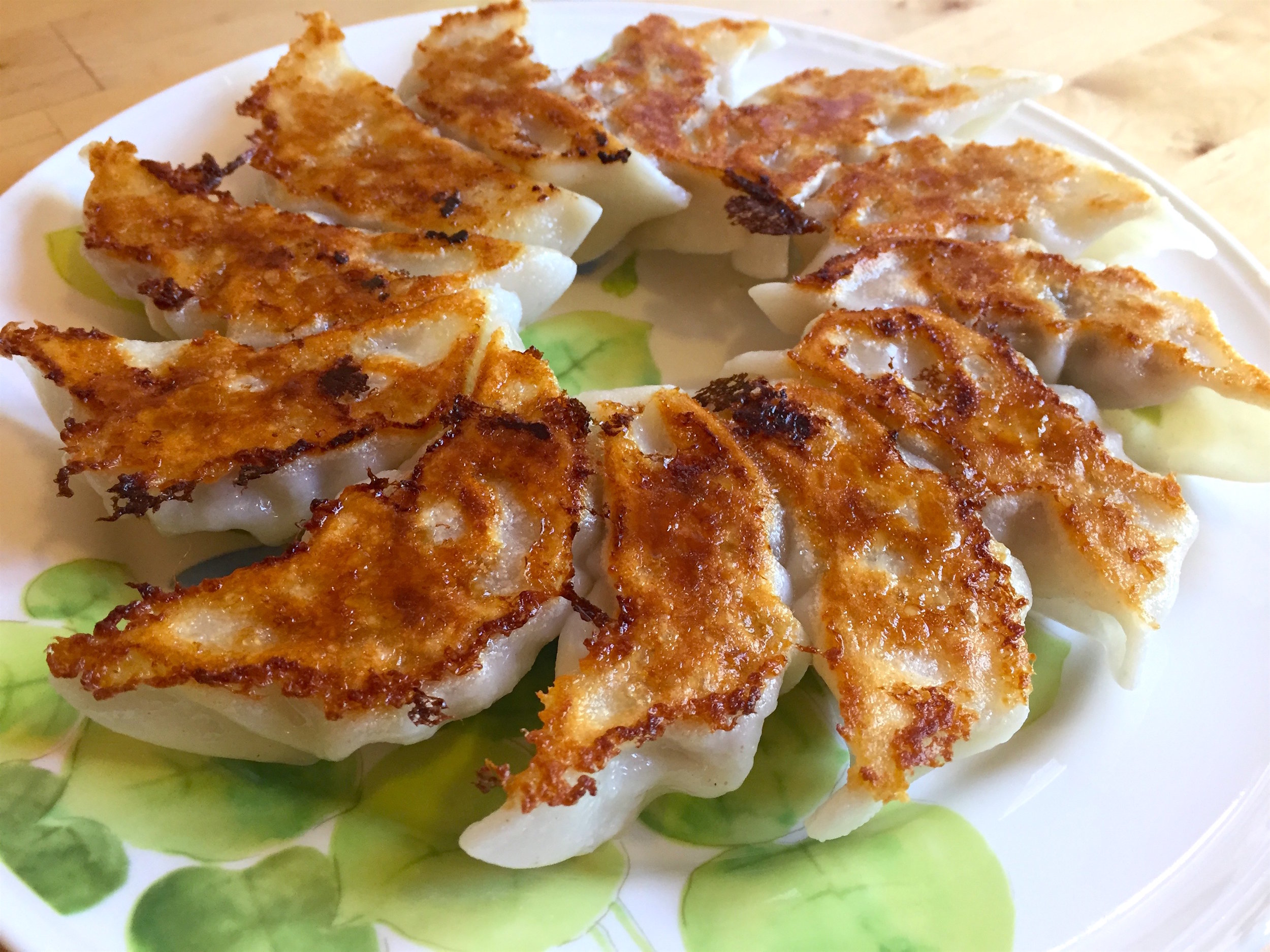Pork and Cilantro Dumplings

豬肉香菜水餃
(Zhu Rou Xiang Cai Shui Jiao)
Cilantro (also known as coriander) is a polarizing herb—many love its fragrance, though some find its taste to be bitter and soap-like [1]. Cilantro is common in Chinese cooking, so much so that in some markets it is sold under the moniker, “Chinese parsley.” However, the cilantro plant actually hails from the Middle East and Southern Europe, where it was first domesticated [2]. The herb made its way to China via the Silk Road. Today, pork and cilantro is a classic dumpling filling, a flavor particularly popular in northern China.
Ingredients
1½ lb ground pork
1 pkg round dumpling wrappers
2 cups cilantro, chopped
1 inch ginger, minced
3 scallions, chopped
1 tbsp cornstarch
1 tbsp soy sauce
2 tsp sesame oil
1 tbsp Shaoxing rice wine (optional)
1 tsp white pepper
½ tsp salt
We will start by preparing the filling. Finely chop the cilantro, taking special care to finely mince the stalks. Add the herbs to a large mixing bowl together with the pork, salt, pepper, soy sauce, sesame oil, rice wine, and cornstarch. Mix thoroughly with a large spoon or clean hands, until the filling until well-combined.
At this point you will want to check for seasoning—the best way to do this is to take a small scoop of the filling and microwave it for 30 seconds or so, until it’s fully cooked. Adjust the seasoning to your taste, then prepare to wrap. You can prepare the filling up to two days in advance of wrapping if you wish. Cover tightly and store in the refrigerator.
On a clean table or counter, prepare a workspace for wrapping the dumplings. The dumpling wrappers, if frozen, should be fully thawed. It is important to stop the wrappers from drying out, so depending on how fast you can work, and how humid the air is, it is often a good idea to keep the wrappers covered before wrapping, either with plastic wrap or a clean tea towel. A towel is also useful for drying your fingers. Fetch a small bowl of cold water for sealing the dumplings, and prepare a landing zone for the completed dumplings. If you plan on cooking them all immediately, go ahead and pile the dumplings up on a plate, but if you are planning on freezing the dumplings, prepare a plate, cutting board, or sheet pan covered in plastic wrap or parchment paper. The dumplings should be placed in a single layer with a small amount of distance between them so they freeze individually.
There are a variety of shapes dumplings can be wrapped in, and today we will be creating a simple shape commonly used for 水餃. Remember that a dumpling doesn’t have to be picture perfect to be tasty—as long as the dumplings are tightly sealed and there are no large air bubbles, they will cook up great.
Begin by placing a wrapper in the palm of your hand and scooping about 1 tablespoon of filling into the center of the wrapper. The ideal amount of filling will depend on the size of your wrapper, so adjust this amount as you go. With your other hand, dip a finger in the cold water and run it around the whole perimeter, moistening the edge of the wrapper. This very small amount of water is meant to help the wrapper to stick to itself—it should not be enough to form droplets or run. Dry your finger on the towel, and then pinch the wrapper together at the top. Then bring the two sides of the wrapper together at the top, pressing them together to form an open half-circle. Fold each corner of the half-circle in on itself, and press to seal the corners. Then seal the rest of the edge together, pressing the air out as you go. Finally, twist a single pleat at the top of the half-circle to ensure that the dumpling stays sealed.
When you are done wrapping, if you intend on freezing the dumplings, put your parchment or plastic wrap lined surface into the freezer. After 6 hours or so, the dumplings should be rock solid. Transfer into a zipper storage bag for convenient storage in the freezer.
To Cook
Boiled dumplings (水餃) are the most common home preparation of dumpling, and the simplest to execute. The only big problem to avoid is the dumplings coming apart when cooking. To avoid this, minimize the turbulence in the water by keeping the pot from reaching a rolling boil.
In a large pot, bring water to a boil. When the water is boiling, add the dumplings to the pot, stirring several times to prevent sticking. As with cooking pasta, use a generous amount of water and do not crowd the pot.
When the pot returns to a boil, turn the heat down to a simmer and cook, covered, until the dumplings are fully cooked. This should be approximately 5-8 minutes if you are cooking them fresh, and 15-20 minutes if you are cooking them from frozen. They are done when the skins turn from white to translucent and the meat inside is fully cooked. Generally the pleated seam is the last part of the skin to be fully cooked, and for potstickers of this size, you can be fairly confident that by the time that the seam is fully cooked through, the rest of the dumpling is also cooked.
Remove from the pot with a slotted spoon, and serve with the dipping sauce of your choice. Generally soy sauce based, dipping sauces may also include sesame oil, rice vinegar, chili oil, satay sauce, ginger, and/or garlic. My personal preference when it comes to a dipping sauce for pork and cilantro dumplings is a mix of soy sauce, your favorite chili crisp, and some fresh cilantro.
Substitutions
Ground lamb or beef work well in this recipe in place of ground pork. I do not recommend ground chicken in this dumpling recipe, as the mild flavor of chicken does not stand up well to cilantro.
Dumpling wrappers can be found either in the fresh noodle section or in the frozen section of most Asian supermarkets. For this recipe, go for the thicker dumpling wrappers, rather than the thinner wonton wrappers. If you can’t find pre-made dumpling wrappers, or just wish to make your own, follow this recipe here.
[1] Research has revealed that nearly 25% of humans carry an allele of an olfactory receptor gene that is highly correlated with aversion to cilantro (Eriksson, et al., 2012). This result strongly suggests that whether you like cilantro or not is probably genetic!
[2] Desiccated cilantro seeds have been found in caves in Israel dating to around 6000 BCE. The first written record of cilantro appears in the Ebers Papyrus, an Egyptian medical text dating to the 1500s BCE.
Recipe
Prep Time: 1 hr Cook Time: 20 min Total Time: 1 hr 20 min
Difficulty: 3/5
Heat Sources: 1 burner
Equipment: pot
Servings: 40 dumplings
Ingredients
1½ lb ground pork
1 pkg round dumpling wrappers
2 cups cilantro, chopped
1 inch ginger, minced
1 tbsp cornstarch
1 tbsp soy sauce
2 tsp sesame oil
1 tbsp Shaoxing rice wine (optional)
1 tsp white pepper
½ tsp salt
Instructions
1. Finely chop the cilantro and mince the ginger. In a large bowl, combine the ground pork, salt, pepper, soy sauce, sesame oil, rice wine, cornstarch, chopped cilantro, and minced ginger. Mix the filling until well-combined.
2. To begin assembly, prepare a small bowl of water, and unwrap the dumpling wrappers, keeping them under plastic wrap or a clean tea towel.
3. To wrap, begin with a single wrapper in your hand. Spoon approximately 1 tablespoon of filling in the center of the wrapper, and moisten the edge of the wrapper with water using the tip of your finger. Seal the wrapper, forming the dumpling into the proper shape.
4. Once all the dumplings are wrapped, cook immediately, or freeze.
To Cook
1. Bring a large pot of water to a boil, and add dumplings to the water.
2. When the pot returns to a boil, reduce the heat and simmer until fully cooked—approximately 8 minutes fresh, or 15-20 minutes frozen.
3. Remove from the pot with a slotted spoon and serve.















